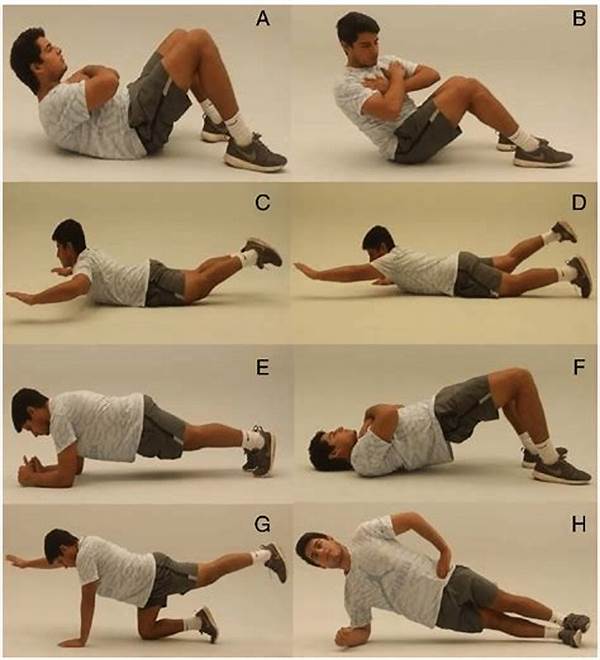Hey there fitness enthusiasts! If you’re keen on leveling up your workout game, you’ve landed in the right spot. Today, we’re diving into the world of core fitness and stability techniques – those underappreciated powerhouses that often get overshadowed by more glamorous workouts. Let’s unpack how these techniques can transform not just your workout but also your daily life.
Read Now : Daily Core Strength Routine Plan
Why Core Fitness is the Game-Changer for Stability
Alright, let’s chat about why core fitness and stability techniques are so important. Think of your core as the foundation of a skyscraper. Without a strong foundation, everything on top becomes shaky and unstable. The same goes for your body. A solid core enhances stability, enabling you to perform everyday tasks more efficiently and with ease.
Nearly every movement starts from your core. Whether you’re bending down to tie your shoelaces or hefting a heavy grocery bag, a strong core ensures balance and prevents injuries. By incorporating core fitness and stability techniques into your routine, you’re establishing a strong base that supports all movements. Plus, you’re setting the stage for improved posture, which not only looks good but also negates those pesky aches and pains from hunching over desks or screens all day.
Embracing core fitness doesn’t mean you have to commit to endless crunches or planks. It’s about engaging your core in everyday activities, making workout sessions more dynamic and effective. It’s about unlocking your body’s potential, giving you that extra boost in athletic performance, be it running, swimming, or lifting.
Essential Core Techniques to Try Out
Let’s break down some core fitness and stability techniques that are must-tries in your next workout session:
1. Plank Variations: Get creative with planks by incorporating side planks or introducing dynamic movements like shoulder taps to engage all core muscle groups.
2. Russian Twists: Sitting on the floor with knees bent, lean back slightly and twist your torso, holding a weight or medicine ball to intensify the workout.
3. Bird Dogs: This exercise involves extending opposite arms and legs while on all fours, ensuring the core remains tight for stability and balance.
4. Dead Bugs: Lying on your back, alternate lowering opposite hand and leg towards the floor, maintaining core engagement continuously.
5. Leg Raises: Lifting legs straight up while lying down focuses on the lower abs – a crucial component of core fitness.
Benefits of Incorporating Core Workouts
Now, let’s dig into the myriad benefits that core fitness and stability techniques can offer. When you start introducing these exercises, you’ll notice an increase in balance and coordination. These qualities are vitally important whether you’re navigating a crowded street or trying new sports like surfing or rock climbing.
Another less talked about but equally fantastic benefit is improved breathing. Core muscles, including the diaphragm, play a significant role in our respiratory system. A robust core allows for deeper, more efficient breaths, helping reduce stress and improve overall well-being. Who knew that core fitness and stability techniques could also bring zen-like calm into your life?
Moreover, let’s not forget that toned abs are a delightful bonus. A consistent core regimen can help sculpt your midsection, making you feel and look fitter. The visual transformation is just a cherry on top of the profound functional benefits your body receives.
Specific Core Stability Moves You Should Know
Not sure where to start with core fitness and stability techniques? Here are some effective exercises to consider:
1. Medicine Ball Slam: Engages the entire core while channeling energy through explosive movements.
2. Stability Ball Roll-Outs: Focuses on extending the core, enhancing both strength and endurance.
3. Windshield Wipers: A challenging move that emphasizes rotational strength while engaging the obliques.
Read Now : “rising Stars Under 30 In Hollywood”
4. Single-Leg Deadlift: Promotes balance and core integration by requiring stability on one leg.
5. Cable Woodchop: An excellent rotational exercise that mimics natural body movements.
6. Pendulum Plank: This dynamic move involves swinging legs side to side while maintaining a plank position.
7. Reverse Crunches: Targets the lower abs efficiently, focusing on core isolation.
8. Seated Balance: Challenges the core to remain upright and stable without the support of legs or arms.
9. Pilates Hundred: A classic move that employs breath control and core contraction for increased stamina.
10. Core Rotation with Resistance Band: Enhances dynamic stability through rotational force.
Implementing Core Stability in Everyday Life
Now, let’s wrap up with how you can incorporate core fitness and stability techniques into your daily life. You don’t need a gym membership or fancy equipment. Your body is the best tool you’ve got! Think of those daily chores as an opportunity to work your core. Whether it’s vacuuming or gardening, employ those core muscles to stabilize your movements.
Another clever trick is to transform your workstation. Opt for a standing desk or incorporate balance discs while seated. These small changes engage your core subtly yet effectively throughout the day, making core fitness a part of your lifestyle rather than just a workout.
Lastly, don’t forget mindfulness. Core fitness and stability techniques are more than physical exercises. They connect your mind and body. Practice focusing on your core during meditation or yoga, and you’ll see greater improvements not only in physical agility but also in mental resilience.
Creative Methods to Boost Core Engagement
Enhancing core stability can also be fun and creative:
Final Thoughts on Embracing Core Workouts
All set to embrace core fitness and stability techniques? Remember, consistency is key. Approach your core workout journey with patience and dedication. The results may not be instant, but they will be worth every sweat session. By investing time in your core, you’re investing in your overall health, balance, and longevity.
So next time you plan your workout, give your core the spotlight it deserves. With every lunge, squat, or crunch, remember you’re building more than just muscle—you’re cultivating strength from the inside out. Here’s to strong, stable, and superbly balanced days ahead!
